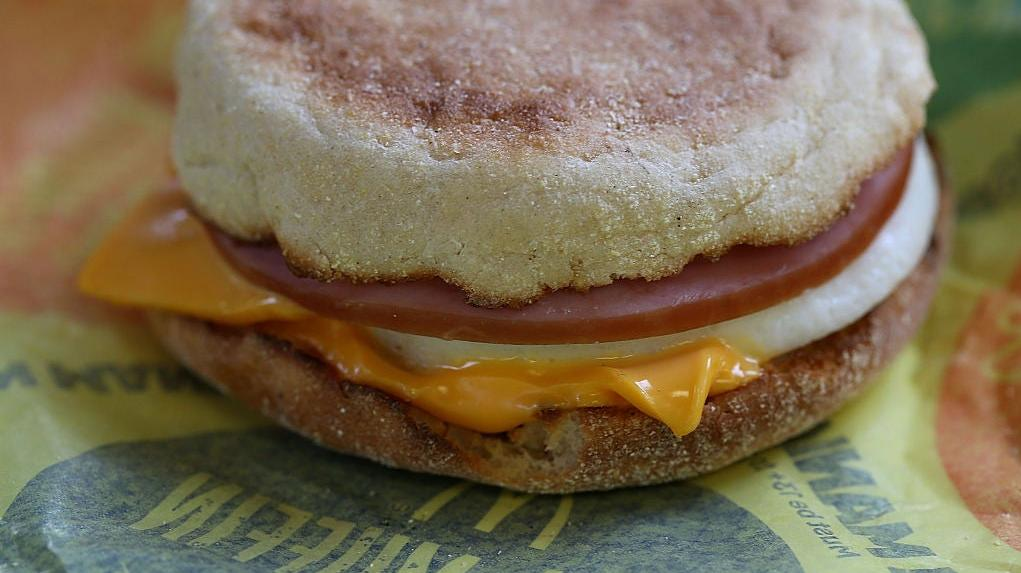TIL McDonald's Serves Five Different Types Of Eggs, And One Is Superior To The Rest
The Takeout would be nothing without its readers, particularly our commenters, who illuminate us so often with their wisdom that an entire section of this site is dedicated to singing their praises. Last week, it was not a reader's unorthodox burger recommendation or scampi brainstorm that caught my eye. It was this note from user MP3|GOD on a post about McDonald's breakfast sandwiches:

"Pro Tip," writes this savvy reader, "any breakfast item can be ordered with the far superior 'round' egg instead of the folded egg that is gross."
A bit of context, for those less familiar with the McDonald's breakfast menu: there is a divergence in the way that eggs are presented on McDonald's breakfast sandwiches. The "round" egg referenced by MP3|GOD is a round disk of cooked egg made from pouring freshly cracked eggs into a metal ring mold placed directly on the griddle. The result is a perfectly sandwich-sized patty, as seen atop the beloved Sausage McMuffin with Egg. Then, by contrast, there is the "square" or "folded" egg, which MP3|GOD deems "gross." You'll find the folded egg on both the McGriddles and biscuit sandwiches. It's true that it's got a springier texture than the round egg, lending a bit more resilience when you bite down on it. It's folded into thirds like a pamphlet, likely done to lend the sandwich more height and perceived heft. It sticks out oddly at right angles from under the round buns and forces you to compress the sandwich between your hands a bit more while you eat. I've never actively thought, folded eggs, yuck!, but yeah, MP3|GOD is right—they're not nearly as good as the round eggs.
Turns out, there are a lot of people who feel this way. One of them happens to be chef/author J. Kenji López-Alt, who wrote an article in 2018 for Serious Eats about the folded egg issue. The headline confirmed our reader's pro tip: "Want Real Eggs at McDonald's? Just Ask!" The term "real eggs" is used because, while the folded eggs are of course made from egg, those patties aren't made on premises like the round egg is. "It's pre-cooked, reheated, rubbery, oddly flavored, not completely unpleasant, but definitely not egg-like," López-Alt writes of the square eggs. Ouch. He goes on:
Well here's the deal: you can get your McDonald's biscuit sandwiches (or any breakfast sandwich, for that matter) made with a 100% real egg, cracked and cooked fresh on-premises. All you've got to do is tell the cashier that you'd like your sandwich made with a "round egg" and they'll replace your folded egg patty with a real egg, free of charge. It'll even appear on your receipt that way.
Sure enough, he provides an image of a receipt with the line item "SUB ROUND EGG." The flavor is altogether more egg-like, López-Alt says, and it's easy to see why in a side-by-side photo. Where the folded egg is uniform in color, thickness, and texture, the round egg is more marbled, with a slight hint of soft yolk in the middle. This is investigative fast food journalism at its finest.
And McDonald's isn't exactly trying to keep this egg thing secret. On the company's "About Our Food" page, the Breakfast section is a treasure trove of info, including a list of the five different ways McDonald's prepares its eggs:
Round Egg: We use a USDA Grade A cracked into an 'egg ring' to get that iconic round shape for our Egg McMuffin®.
Scrambled Eggs: Our scrambled eggs are made with liquid eggs that are cooked fresh on our grill with real butter.
Egg Whites: At participating McDonald's, we use 100% egg whites in our Egg White Delight McMuffin®, cooking them on our grill with real butter in an 'egg ring' for that iconic round shape.
Folded Eggs: Our folded eggs, like the ones on a Bacon, Egg & Cheese Biscuit, are made with liquid eggs that are pre-cooked and folded before being flash frozen by our suppliers. Once in our kitchens, they're prepared on the grill with real butter.
Sausage Burrito Eggs: Our suppliers pre-cook liquid eggs with ingredients that include sausage, tomatoes, green chiles, onions and seasonings before flash freezing them to help maintain their taste.
I appreciate that these explanations aren't bogged down by marketing jargon about how "farm fresh" the eggs are or whatever. It's just a straightforward description of how each of these eggs make it from the factory to the customer. Sure enough, the round egg is the only one starting from a shell, on site, rather than using bulk liquid eggs that traveled from a supplier (either in that liquid form or pre-shaped).
Of course, there's nothing inherently wrong with the liquid eggs, nor with the folded/burrito/scrambled eggs they become. For some people, a slick egg white or a jammy egg yolk might be the last thing they're looking for in a McDonald's breakfast sandwich, and that's fine. Those customers will save precious milliseconds at the drive-thru by opting for the default egg instead of a substitution. For the rest of us, this is a valuable bit of intel that gives us more control over our breakfast orders than we might have realized we had. I can't wait for my next road trip.
